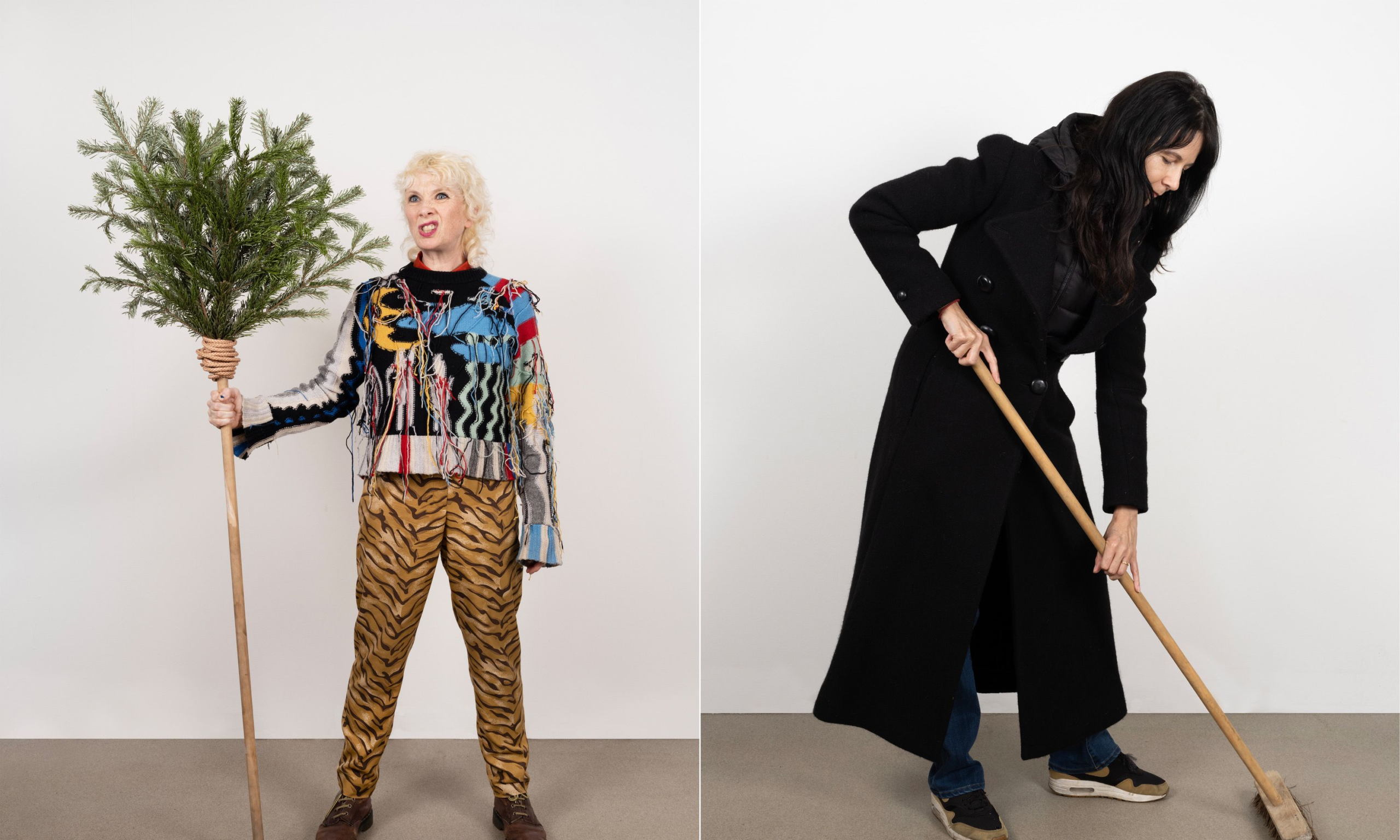Gillian Wearing, Maggi Hambling, Sarah Lucas and Georgina Starr, some of the female British artists in the exhibition BIG WOMEN, brandishing homemade broomsticks Photo: Katie Morrison; courtesy of the artist and Sadie Coles HQ
Sexism and ageism still stalk the art word, not to mention the world at large. But this month these twin evils are given a thorough trouncing in a pair of shows that confirm the power of the older woman, and especially when sisters of a certain age do it for themselves.
This is what the artist Sarah Lucas has achieved with BIG WOMEN, a big-hearted, multifarious exhibition that she has organised at Colchester’s Firstsite, which comprises paintings, sculpture, film and fashion by 23 of her female peers, as well as by Lucas herself. “The older woman is often overlooked, irrelevant, and without currency,” Lucas says. “We live in an increasingly ageist society and this affects women disproportionately.”
The show's title comes from a 1990s TV drama written by Fay Weldon about a group of female friends who set up a feminist publishing house; and the same spirit of female comradeship pervades Lucas’s show. “I see BIG WOMEN as both an endorsement and a celebration of women’s achievements in the creative field” she says.
Left to right: DJ and fashionista Princess Julia and fashion designer Pam Hogg
© Princess Julia. Courtesy of the artist and Sadie Coles HQ; London. Photo: Katie Morrison / © Pam Hogg. Courtesy of the artist and Sadie Coles HQ; London. Photo: Katie Morrison
Ages span from the baby of the group, 43-year-old Polly Morgan, whose disquieting photoworks feature unholy alliances of flayed taxidermied snakes and acrylic fingernails, to Maggi Hambling, aged 77, and her giant sculpture of Francis Bacon’s muse Henrietta Moraes eating a meringue, and a vividly painted nude by octogenarian Sonia Coode-Adams. In between are works by a formidable clutch of 50 and 60-somethings, including Fiona Banner, Gillian Wearing, Georgina Starr, the fashion designer Pam Hogg and legendary DJ and fashion icon Princess Julia, as well as a band of Lucas’s own striking ‘bunny’ sculptures.
Lucas was part of the feisty crew that studied alongside Damien Hirst at Goldsmith’s College of art in the late 1980s and two of her fellow female classmates—Angela Bulloch and Abigail Lane—are among the BIG WOMEN line up. All three were also participants in Hirst’s landmark Freeze London exhibition in 1988, which to a great extent put that generation on the art map. But while Lucas concedes that the show “made a big splash”, she also points out that “predictably it was the male artists who were approached by the commercial galleries…it was quite a depressing moment… a wake up call for me.”
Now the art world is at last bestirring itself to address the gender imbalance – Lucas has a solo show at Tate Britain later this year -but age remains an issue. At the photoshoot for BIG WOMEN Lucas mockingly acknowledged society’s enduring disregard for older women by stipulating that everyone “bring your own broomstick”. Armed with their often elaborately customised broomstick armoury, each participant at this most formidable of covens powerfully confirmed that—to paraphrase Shakespeare’s comment on Cleopatra—age has not withered nor custom staled their infinite variety.
Installation shot with Phyllida Barlow's Hollow ()2022 and Rachel Whiteread's Untitled (Crease) (2021) in background.
Photo: Louisa Buck
Shakespearean witchy vibes are also conjured up in Hurly-burly, a three woman exhibition of sculpture by Phyllida Barlow, Rachel Whiteread
and Alison Wilding at Gagosian in Paris. The title makes playful reference to the speech of the three witches in the opening scene of Macbeth: “When shall we three meet again?/In thunder, lightning or in rain?/When the hurly-burly’s done/When the battle’s lost and won.”
The trio have known each other since Wilding and Barlow taught Whiteread at Brighton Polytechnic in the mid-1980s and the name of the show is also an apt description of the way in which each in different ways have navigated the hurly-burly of the art world and lost and won a fair few battles along the way. “We’ve all seen art sensations—literally and metaphorically—come and go and […] those may have impacted all of us,” says Barlow.
Left to right: Alison Wilding, Rachel Whiteread and Phyllida Barlow with Wilding's work in front
Photo: Louisa Buck
But amid these tumultuous times their four-decade friendship has endured. “There has always been this support network among ourselves,” says Whiteread, who instigated the Gagosian show after Wilding originally suggested it many years ago. “I think without a doubt, the fundamental thing is that we all really respect each other, and respect each other’s journey in art,” she adds. “We are all great inventors and we all use materials in very different ways. But I think we’re all alchemists in the way we use materials.”
Hurly-burly includes several pieces by each artist, some historical, some made especially for this show. And in the very latest work—whether Barlow’s teetering conglomerations of painted wood, scrim and plaster; Whiteread’s combinations of recycled branches, fencing and corrugated iron all coated in pristine white; or Wilding’s latest fusings of precious metals, laminate and acrylic, there can be no doubt that their alchemical powers are firing on all cylinders.
So, speaking as a sixty-something female myself, let’s all of us echo Wilding’s call: “Hurly-burly, bring it on!”
• BIG WOMEN: Curated by Sarah Lucas, Firstsite, Colchester, 11 February-18 June
• Hurly-burly, Gagosian Paris, until 4 March

